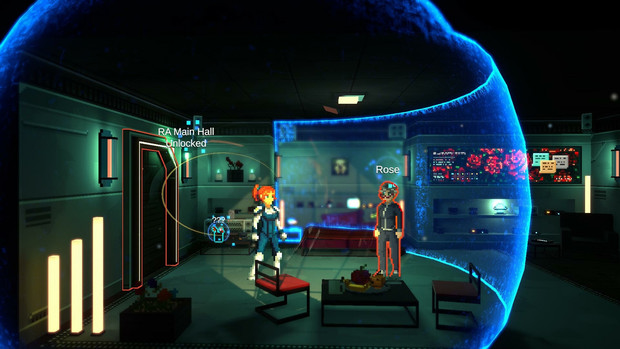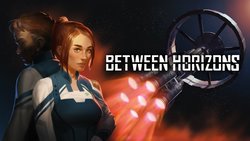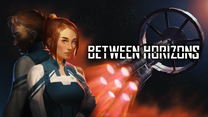Between Horizons review

- 0 Comments
Nothing middling about this stellar sci-fi pixel art investigative mystery from the creators of Lacuna
Space, the final fr–
Wait, hold on! And while you’re at it, forget about a galaxy far, far away and stop that iconic “Also sprach Zarathustra” track as well! Get those well-known science fiction tropes out of your mind and clear the way for something completely different.
How about a detective story set on a generation ship traveling to colonize another world? Perhaps still a familiar premise for sci-fi aficionados, but Between Horizons takes that notion and sets itself apart by presenting it as a 2.5D sidescroller with a village-sized cast, lots of secrets to a catastrophic conspiracy to uncover, and only one woman able to save humanity. Even though I try to avoid more sci-fi heavy games, I was very much intrigued when I embarked on this space adventure, as it has such a human story with a main focus on gathering clues and identifying suspects. And I’m glad I did, as other than a somewhat clumsy user interface, it completely won me over.
DigiTales Interactive’s second game, following 2021’s Lacuna (which I must admit I haven’t played yet – but certainly will now!) charmed me with its story, characters and detective-style gameplay. You take on the role of Stella, who succeeds her father as head of security on board the starship Zephyr – which gives you the perfect excuse to snoop around everywhere you want in this semi-open world! This ship is on its way to colonize Eurus-d, a planet in a solar system many light years away. It’s been traveling for 33 years already, but only the current inhabitants’ future grandchildren will ever set foot on solid ground again.

With its population of 1,300 souls, the Zephyr is a flying town divided into four sections: the command sector with the crew; the public center with a school, a gym, an art institution, a museum, a café and an activity room; the residential neighborhood filled with apartments; and the science wing with its hospital, laboratories and farm. It’s generally a rather dark place, with neon lighting and bright information panels with animated schematics strewn about for that futuristic look. Lots of dark blues and greens for the main public areas, brown and rust red for the lower power levels, while the hospital and farm are given relatively brighter palettes, all presented in stylish pixel art.
Each of these areas is heavily populated. You’ll see people hanging out in the background, in the foreground, walking through the corridors, and you’ll constantly hear the ambient noise of a surrounding crowd. The place is brought further to life by small environmental sound effects like swooshing doors, sparks, dripping water, engines humming, and a soundtrack reminiscent of 90s-era fictional police procedurals and medical TV shows, combining military drums with a more jazzy piano lounge feel as well as futuristic synths and even trance elements. Every sector on the ship has its own specific score.
You navigate through the circular Zephyr in a side-scrolling fashion, moving Stella around with WASD. There is no possibility to rebind the keys, unfortunately, and there’s no mouse control over Stella herself, though you can use it to click away dialogue text (there’s no auto-advance) and to navigate the Dashboard (more on this later). It takes roughly 2.5 minutes to walk all the way around the ship, but there’s a sprint button or you can fast-travel from one general area to another by using one of four train stations. There’s a handy in-game map if you need to get your bearings, from which you can also quickly access those train stations and travel to the other side of the ship with a click of a button. Personally, I preferred walking everywhere, since this opened up lots of optional conversations with NPCs you meet along the way. Which perhaps explains why it took me seven hours to complete a game that can probably be done in five. The Zephyr has several levels on top of each other, which you can access either by taking the stairs or by using one of two available elevators.
In-game character models are designed in fairly low-detailed pixel art, with eyes but no noses or mouths. This sometimes makes it hard to tell them apart, but they’re shown with beautiful multi-expression character portraits during conversations. Dialogues aren’t voiced, but Stella sometimes takes on the role of narrator after important scenes. While the text slowly scrolls upward in the middle of the screen, her British-accented voice could have used a bit more emotion at times. But perhaps this is simply meant to convey her weariness, telling her story after the events took place. The displayed text, both of the narrator sections and the regular conversations, could have used one more proofread, but I was quite forgiving of any typos here since the story pulled me in as relentlessly as a black hole. The adrenaline of conducting crucial investigations and the subsequent revelations just kept me constantly wanting more.
That story revolves mainly around playing detective with the highest possible stakes. During your time on the Zephyr, several things go wrong and as chief of security, it’s your job to find out who is responsible for the mayhem. There are mysterious messages hinting at an underground movement planning a coup, an explosion taking out the power nodes, a hacker taking over the navigation system, an old criminal case involving a man using the farm’s fertilizer to build a custom bomb, and of course the main reason you are chief of security: the death of your predecessor and father William, which you never truly considered purely accidental.
At the start of Between Horizons are a couple of tutorials explaining the inner workings of your investigations. You can skip them if you want, but you won’t be able to view them again later on. After detailing Stella’s general controls, these tutorials all center on the “Dashboard” of her PDA. Consider this as your personal database of everything that goes on aboard the Zephyr. You can continue using the keyboard while navigating the Dashboard, but that can be quite cumbersome. Thankfully the game allows complete mouse control in regular point-and-click fashion for this part, as it’s far easier to scroll through the different tabs than constantly tapping the directional keys.

Next to the map, the Dashboard contains not only a speech log of all conversations you have, but also direct messages you might receive from these NPCs. Stella also keeps a list of the cases she’s investigating, and all uncovered information related to a particular case will automatically be added there, with keywords displayed in a bold red. Last but not least, there’s the evidence tab, containing a list of everyone you meet throughout the story, the locations you've visited, and all important items and clues you’ve discovered. As you progress, more evidence is added, making it harder and harder to locate the right one when needed, since they’re always shown in the sequence you encountered them, and you can’t categorize or order them in another way.
Each of the ten cases you tackle will demand that you answer a key question. Usually you will need to pin the offense being investigated on a particular suspect, whom you have to choose from your list of NPCs. Sometimes a case asks for a particular piece of information instead, like where a certain theft occurred. It’s your job as chief of security to conduct an investigation, gather all clues and information to compile a list of possibilities, then figure out how to rule them all out except the true one. Sometimes there’s some light puzzling involved, for instance by comparing timestamps or making certain mathematical calculations, but this is definitely not a puzzle-heavy game. Challenges start off quite easy, but there’s a rising difficulty level as you progress, with more leads to follow per case, as well as having to juggle multiple cases at the same time.
In Between Horizons, you’re actually forced to employ what could be considered a hotspot locator – or better yet: activator – which is well-integrated into the gameworld design. Stella’s suit is equipped with a scanner, which highlights all points of interest in a room, from something dropped on the floor, to important information shown on one of the many panels, to other characters standing nearby. Except for the characters, which are always available for interaction, the hotspots only show up after you employ the scanner, and they are only available for examination for a limited amount of time. You look at these hotspots or talk with NPCs by tapping a default action key, and with a secondary key you can question people about everything in your evidence database.
Along the way, you will have to make lots of decisions. During regular conversations, you’ll often have to choose your reply. For instance, you can play it by the book and enforce all on-board rules no matter who’s standing in front of you, or you can decide to turn a blind eye and make certain allowances for people you might have a special relationship with. You can even raise the difficulty level by activating an optional timer for choosing these dialogue options, but beware that every decision you make will have an influence on some detail or other of how the story will end. You can even get each case’s one central question wrong if you’re not careful. It’s very possible to miss a piece of information, resulting in you pointing out the wrong suspect, which then branches off in a new direction that will ultimately lead to a different final confrontation. After this, the storylines converge again somewhat and the game will initiate one of two possible endings.
Now here’s the rub: the developers have very intentionally designed Between Horizons so that every decision you make will be set in stone. There are no take-backs, which is enforced by allowing no manual saves and only ever having a single save file for each playthrough. The game autosaves quite frequently, such as after every conversation or every clue you find, so from a practical standpoint it’s easy to quit the game and continue later on, especially with that complete speech log to remind yourself of your progress later, but there’s a high price to pay for this convenience. Want to do something different? You’ll have to start from the beginning again. Accidentally made the wrong choice? Sorry, that’s life; no do-overs in the real world either. I guess it does make the game more realistic, and it makes the weight of your decisions heavier and you won’t as easily jump to conclusions. But it’s an awfully punishing approach that may end up discouraging replays rather than encouraging them as is clearly intended, though you do have the option of bypassing all the legwork for each case you’ve already finished successfully by inputting the correct answer right away, effectively skipping them altogether.
Final Verdict
While the user interface takes some getting used to, and the script could have used a little more polish, the story and investigative gameplay of Between Horizons are highly entertaining. I really enjoyed playing as Stella, molding both her character and the story’s ultimate outcome with my dialogue choices and efficiency as the Zephyr’s chief of security. I loved roaming around the spaceship looking for clues and talking to other characters, each with their own unique personality and background, with not one but ten different mysteries to investigate. And there’s a great amount of detailed worldbuilding, both visually and narratively found in this game. It’s a shame that trying for a different outcome demands another complete playthrough, but I was very satisfied with the ending I got, despite only finding the right solution for eight out of ten cases. Even if you’re like me and generally have no real affinity for science fiction, this intriguing detective/sci-fi story aims for the stars, and as far as I’m concerned it’s mission successful!
Hot take
It may have a few minor malfunctions, but Between Horizons launches players on an exciting and branching interstellar detective journey, looking for clues, questioning suspects, and maybe saving the remnants of humanity in the process.
Pros
- Out-of-this-world detail both in setting and character creation
- Intuitive investigative gameplay
- Handy speech log of all conversations
- Branching storyline offers multiple paths and alternative endings based on your choices and success rate
Cons
- Lacks a manual save system
- Script would have benefited from an extra proofread
- In-game Dashboard can become a bit unmanageable as your database grows
Johnny played Between Horizons on PC using a review code provided by the game’s publisher.











0 Comments
Want to join the discussion? Leave a comment as guest, sign in or register in our forums.
Leave a comment